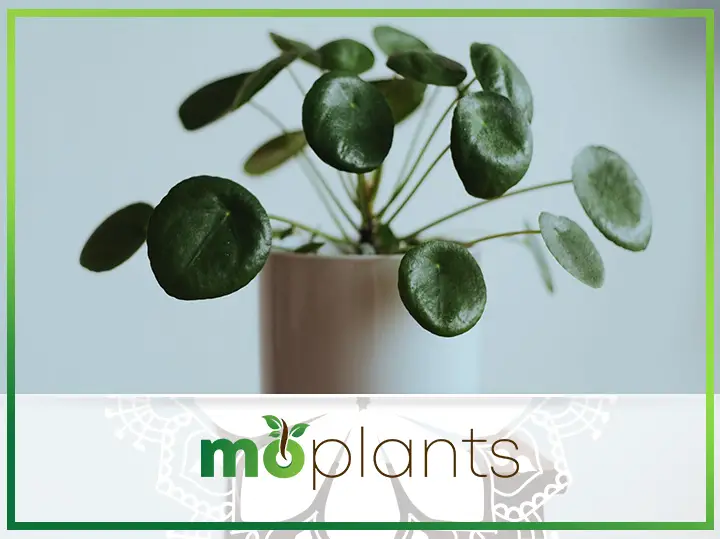Featured frequently in Scandinavian interior designs, the Chinese money plant’s flat and glossy coin-shaped leaves are a sight to behold. The bright green foliage of this plant can add a pop of color to any room, making your space look brighter and more aesthetically pleasing. If you like to keep up with the latest home design trends or have a fondness for growing unique floras, you would have most likely heard about the simple beauty and undemanding nature of this gorgeous houseplant.
The signature disc-shaped leaves of the Chinese money plant have earned it quite a few interesting nicknames – including missionary plant, lefse plant, UFO plant, and most popularly, pancake plant. This eye-catching houseplant is also very easy to grow and care for. Even if you don’t have a green thumb or have trouble keeping plants alive for long, looking after a Chinese money plant is going to be a piece of cake.
The lush foliage of this plant can also add depth and texture to any dull and dreary spot in your home.
Introduction: Chinese Money Plant
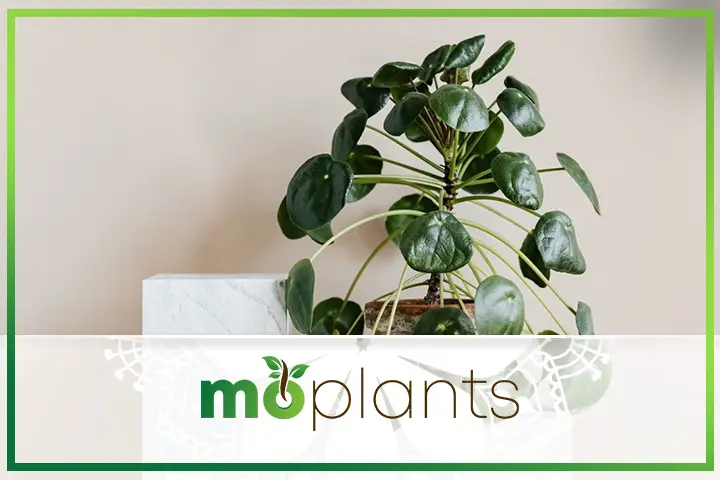
The botanical name of the Chinese money plant is Pilea peperomioides. It is an evergreen perennial from the Urticaceae or nettle family.
Since this plant is commonly found in Scandinavian homes, its origin stumped researchers for quite some time. However, they eventually figured out that the Chinese money plant is originally found in China’s southwestern Yunnan province.
As the story goes, a Scandinavian missionary visited China in the 1940s and brought home a few cuttings of this charming plant. They not only planted the cuttings of Pilea peperomioidesbut also shared them with their friends and relatives. Soon enough, the popularity of the Chinese money plant spread throughout Europe. Since it can propagate without much effort, it became a norm for friends to pass cuttings of this plant as it symbolized wealth and good luck.
The unique leaves of the pancake plant are undoubtedly its most interesting feature. The shiny flat leaves are round like a coin or a pancake, inspiring its two most popular aliases. Though they may seem exceptionally thin, the leaves have a thick leathery texture supported by a long delicate stem. A beautiful mixture of pink and green, these stems begin to twist as the plant gets older.
Moreover, Pilea peperomioides can grow as tall as 40cm. In its natural habitat, the plant produces dainty white flowers throughout spring. However, it does not bloom when grown indoors. In addition, this plant doesn’t require direct sunlight to thrive. You can place it in any bright corner of your home, and it will continue to grow. With proper care and affection, this plant can live for up to 10 years.
Apart from its vibrant foliage, the Chinese money plant is also known for its air-purifying properties. Even with such a small surface, its leaves can readily absorb pollutants and toxins from their surroundings. As a result, you get to enjoy an improved air quality inside your home, which is essential to keep you healthy and stress-free.
It is also worth mentioning that the Chinese money plant is non-toxic to humans and cats, dogs, and other pets. So, if you have any furry companions at home, this plant won’t harm them.
How to Grow Chinese Money Plant
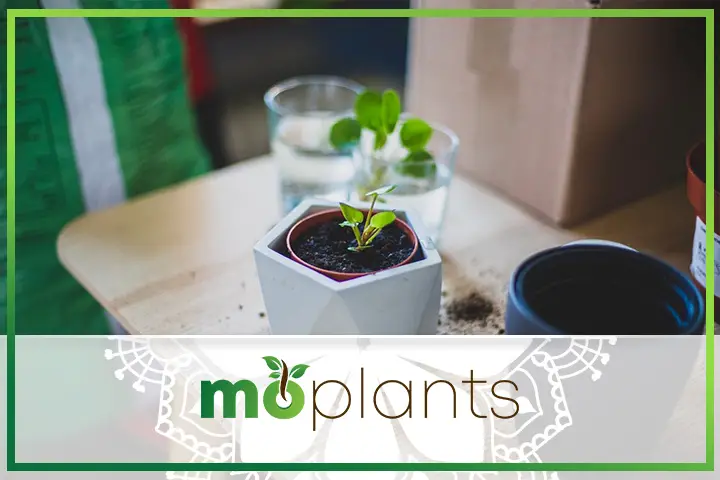
This exquisite plant can be a wonderful addition to your collection. Here are some useful tips on how to grow Chinese money plants in your home.
Position
You can keep your Chinese money plant in any brightly lit corner of your home as long as it doesn’t receive direct sunlight. Since it is non-toxic and has air purifying properties, you can display it on your bedside table, workstation, living room, or kitchen as you find convenient.
However, make sure to rotate it regularly, so the plant grows symmetrically and doesn’t become lopsided.
Ideal Temperature
This plant remains green and healthy throughout the year. It is usually not affected by cold temperatures, but you can move it indoors as soon as the temperature drops to 50 degrees Fahrenheit. However, a brief exposure to cold weather may encourage Chinese money plants to produce flowers.
During summers, you can move this plant outdoors, though they will thrive indoors as well.
Humidity Level
While Pilea peperomioides require average humidity to grow, they can easily survive in high humidity environments. However, they are not a fan of extremely dry weather conditions. So, if you live in a region with very low humidity levels, consider buying a humidifier for your plants. Moreover, it may be good to keep these rare green beauties away from heating vents.
Exposure to Sunlight
If you want to grow Chinese money plant indoors, make sure to keep it in a location that only receives medium to bright light. Please remember that direct sunlight can cause the foliage to wilt and burn, thus damaging your plant.
On the other hand, keeping the plant in the dark corner may also not be a good idea. If Pilea peperomioides does not receive adequate light, its trademark round leaves will become smaller, and the plant will grow fewer offshoots.
Watering Frequency
It is pretty easy to grow Chinese money plant as you only have to water it when the soil is nearly dry. In other words, it has medium water needs and does not require to be watered daily.
To determine if the plant needs water, touch the soil with your fingers. If it feels dry, make sure to water it well. Drooping leaves are also a sign that your plant needs more water. You may have to water it frequently during hotter months and less often during cooler periods.
Potting Mix
The pancake plant can grow well in soil with a pH level between 6.0 and 7.0. While choosing the potting mix, go for a high-quality peat-based or coir-based option. A well-draining soil and a pot with adequate drainage holes will increase the life of your Chinese money plant.
Infographic
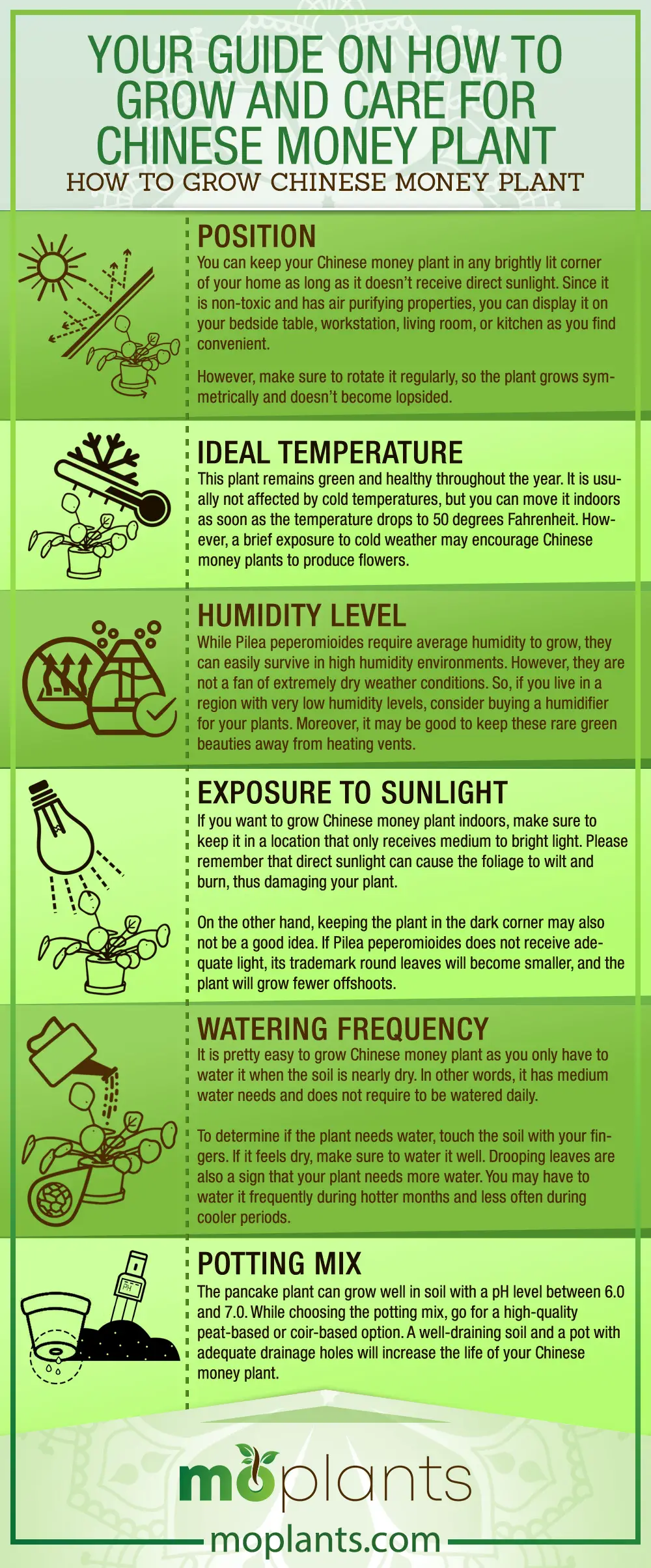
Chinese Money Plant Propagation Method
Although this plant was not commercially available, it still spread throughout Scandinavian countries because it is extremely easy to propagate. One can acquire a cutting of Pilea peperomioides from a friend and grow it into a beautiful plant within a few months. Owing to its ability to propagate quickly, the Chinese money plant is also called the “sharing plant.” It also makes for a great housewarming gift.
There are several popular Chinese money plant propagation methods, but the easiest would be to cut off an offshoot and plant it into a separate container. To do so, select an offshoot that is at least a few inches tall and grows directly from the root system instead of a node on the stem of the mother plant. Follow the offshoot about an inch under the soil and separate it from the plant using a clean knife or sharp shears.
Next, plant the cutting into a separate pot and water it until the soil is adequately moist. Do not waterlog it, but keep the soil moist until the baby plant develops its roots. This process usually takes up to two weeks, after which you can resume your regular watering and fertilization schedule.
Once your Chinese money plant begins to produce coin-shaped leaves and offshoots, you can cut off a few of the plantlets and share them with your friends.
Chinese Money Plant Care Tips
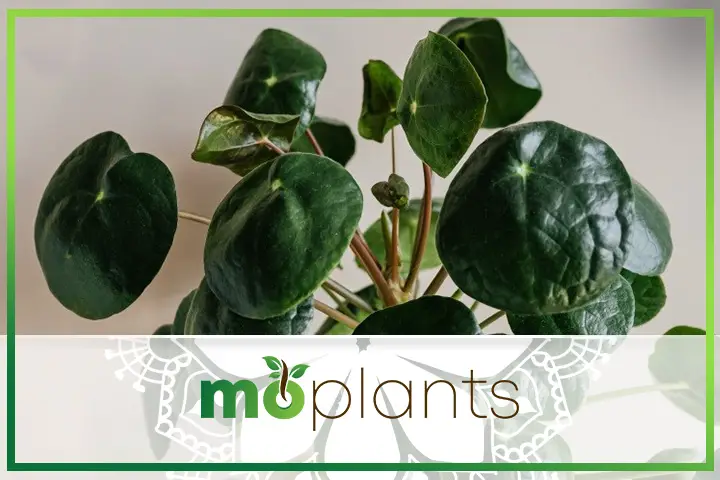
Pruning and Trimming
Pilea peperomioides is not a fast grower, so you don’t have to trim it often. While offshoots mostly develop from the root system, they sometimes also grow from the nodes on the mother plant. If you want your Chinese money plant to have a bushier appearance, you can let these offshoots grow. Otherwise, separate them from the plant using a sharp knife and put them in a separate pot. You can either grow the new plant yourself or give it to a loved one.
Discard Excess Water
Nothing kills a plant faster than overwatering it. Ideally, you should water your Chinese money plant once or twice a week, depending on how quickly the soil dries. If you water it too often, the soil may become waterlogged, causing the roots to rot. Moreover, use pots with a drainage hole to grow Chinese money plant. Don’t forget to throw away the excess water that accumulates in the plates placed under the pots.
Balanced Fertilizer
Your Chinese money plant does not have to be fed frequently. However, if you want your plant to look bright green and healthy, you can treat it with a well-balanced fertilizer every month during the summer and spring seasons. Refrain from feeding the plant during the winter months.
Wiping and Cleaning
These plants are excellent air purifiers, but they won’t clean the indoor air if their leaves are covered with dust, dirt, and other debris. To make sure your plant looks clean and shiny at all times, wash the leaves with water or wipe them with a clean cloth. This is one of the top Chinese money plant care tips that you must know.
Repotting
The roots of the missionary plant need some room to grow properly. Since they are not particularly fast growers, you can move your houseplant into a slightly bigger pot every 12 months or so. Frequent repotting can damage the roots of the plant, whereas not repotting it every year can make it difficult for the roots to grow, resulting in smaller leaves.
Types of Pot
Terracotta pots are usually the go-to choice for most plant lovers. But did you know that terracotta tends to absorb water from the soil, which means you will have to water your plant more often? Although it’s not a deal-breaker, home gardeners need to be aware of this little tidbit before choosing the perfect pot for their Chinese money plant.
Typically, this unique plant grows well in ceramic and plastic pots.
Infographic
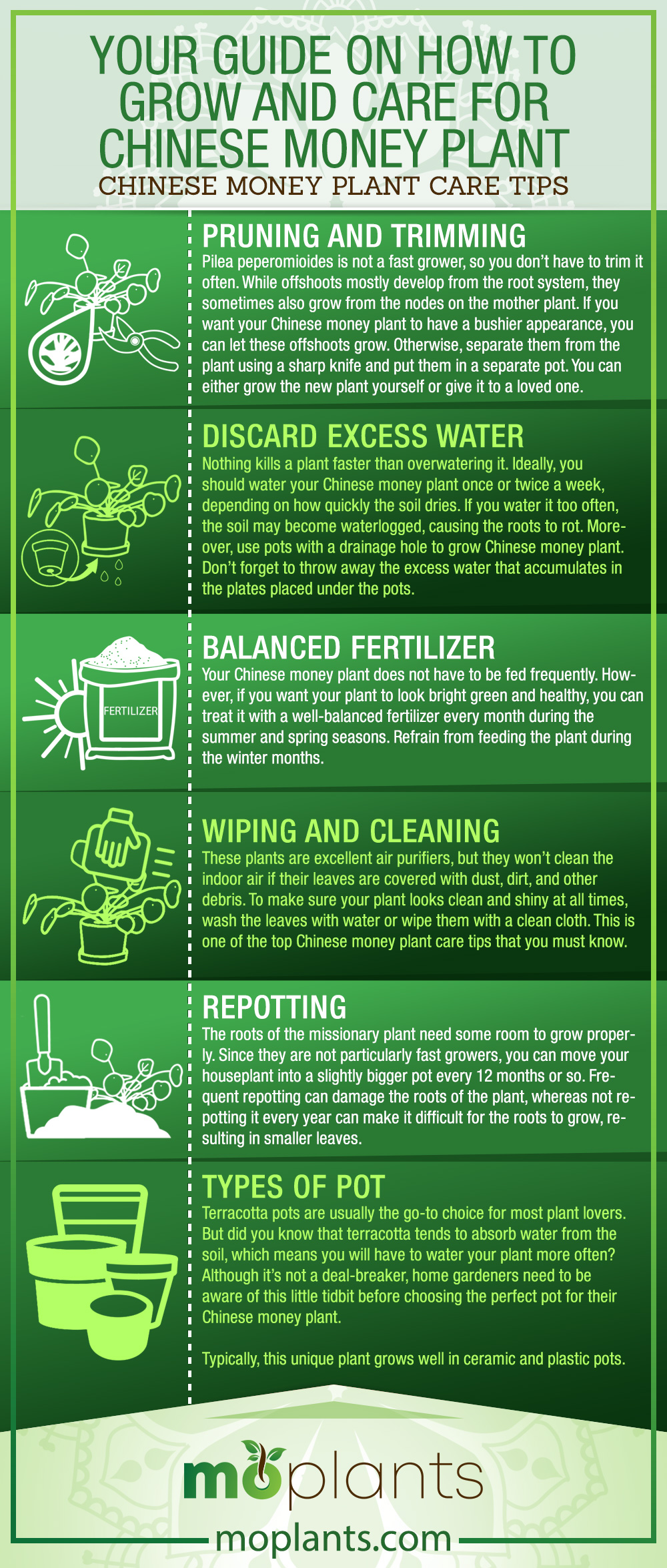
Common Chinese Money Plant Problems and How to Solve Them

Now that we know how to grow and care for Chinese money plants let’s look at some of the most frequent problems you may face while tending to them.
Leaves Turning Brown or Crispy at Edges
If the thick and bright green leaves of your Pilea peperomioides are turning brown or crispy at the edges, it could mean either your plant needs more water or is receiving too much direct sunlight.
The best solution would be to increase your watering frequency and move the plant to a shaded spot. You may also have to adjust the humidity levels in your home to help the leaves regain their color.
Shedding Leaves
Before the coin-shaped leaves begin dropping off the Chinese money plant, they turn yellow at the base. This is a common sign that must alert the owners about the condition of their plant. Usually, moving the pot to a brighter spot and feeding it an all-purpose plant fertilizer is enough to stop the shedding.
Droopy Leaves
Wilted and droopy leaves are also a sign of under-watering. Make sure to keep the soil lightly moist at all times.
Stems Turning Yellow or Black
This is an indication that your plant is about to fall apart. Stems begin to turn soft and yellow when the plant is being overwatered. If the stem has already begun to turn black, it may indicate root rot, which will cause your plant to die shortly.
To treat this disease and hopefully revive your Chinese money plant, move it to a warmer and brighter spot so the soil can dry out quickly. It would also help if you allowed the soil to dry out completely before watering it again. Discard the excess water immediately and do not water it again until the top two inches of the soil are completely dry.
Domed Leaves
If you have noticed the flat, round leaves forming a dome by curling at the corners, it may mean your plant is not receiving enough sunlight. Leaves tend to curve when searching for light, so the best thing you can do is move your plant to a brighter spot in your home. Just make sure the foliage is not exposed to direct sunlight.
White Spots on the Leaves
Sometimes, the minerals in the soil can cause your Chinese money plant to secrete a white substance out of its glossy leaves. This excretion normally takes place if you water your plant with tap water. To fix this problem, you may want to switch to distilled water. Your plant will surely appreciate it.
Pest Infestation and Diseases
Pilea peperomioides is not very vulnerable to pests and diseases. However, it may become susceptible to mealybugs, spider mites, scale, and fungus gnats when grown indoors. If you notice any common pest infestations, wipe your plant with neem oil to ensure it remains healthy and happy.
Chinese Money Plant FAQs
Here are some of the most frequently asked questions about the Chinese money plant care, growth, and propagation.
What’s the best spot for a Chinese money plant?
Ideally, you should place your plant in a bright and warm spot that doesn’t get direct sunlight. Thanks to its aesthetic simplicity, the Chinese money plant will look great in your bedroom, living room, dining room, dorm room, and hallway, among other indoor areas.
Should you mist a Chinese money plant?
Pilea peperomioides grows well in average humid climates. However, if you live in a dry area, misting the plant daily or every other day will help keep it hydrated.
How often should one water their Chinese money plant?
Watering this plant once a week is usually enough. But you may have to increase the watering frequency if the leaves begin to droop.
Are Chinese money plants toxic?
Pilea peperomioides is a non-toxic plant. It may not taste delicious, but it does not poison cats, dogs, and other pets. It is safe for humans as well.

